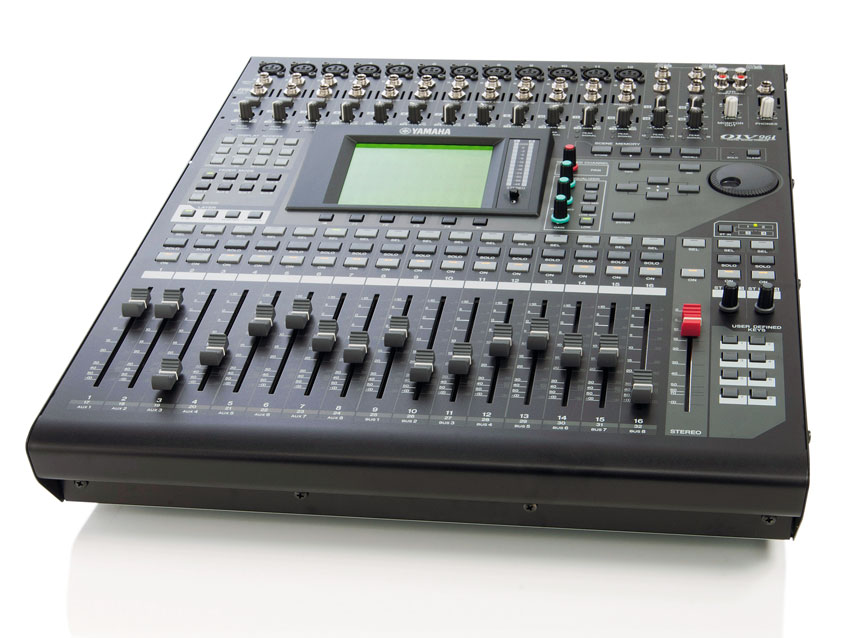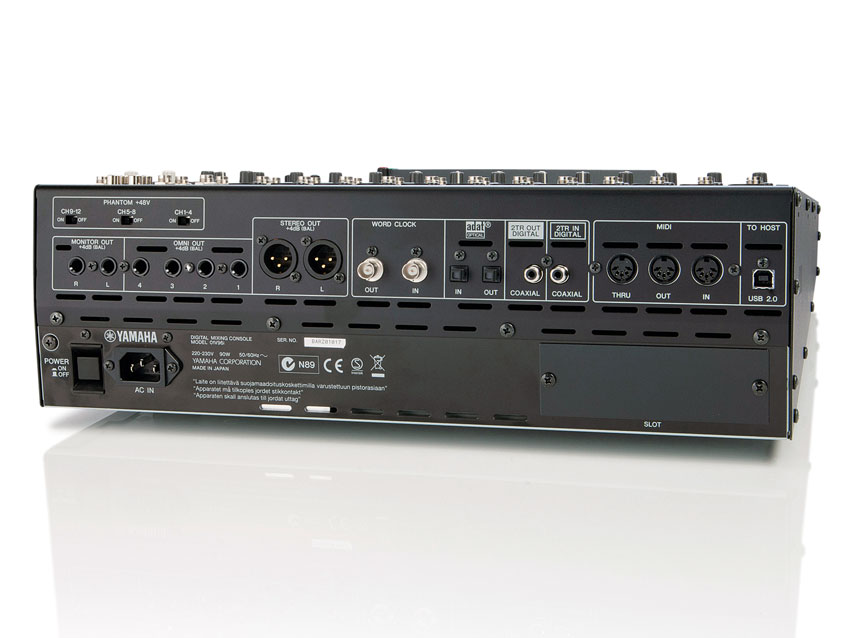MusicRadar Verdict
If you like the idea of a compact-format digital desk, the 01V concept remains a winner.
Pros
- +
Full USB 2.0 audio interfacing. Pre-loaded effects engines. Work in Layers.
Cons
- -
Menu-diving.
MusicRadar's got your back

Yamaha 01V96i Digital Mixer

Yamaha 01V96i Digital Mixer (back)
As has been said countless times before in these pages, the passing of time can be cruel for many of the products released into the music tech world.
Fourteen years ago, when Yamaha first unleashed a line of digital mixers, the DAW-centred recording studio was still finding its feet, while the idea of running an entire mix, complete with automation, effects plug-ins and software instruments, was still a pipe-dream for most. Back then, 'external' digital mixing consoles provided a valuable service and, despite relatively high prices, proved popular as the centrepiece of many a semi-pro and pro studio.
This was perhaps most true of Yamaha's 01V console, which managed to combine flexibility, compactness and, at the time of release, rarely-rivalled audio quality. In the intervening period, countless technologies have risen and subsequently fallen but the fact that this desk, a couple of revisions later, remains in circulation, is testament to its staying power. With a new letter in its name - the 21st century-friendly 'i' - Yamaha have clearly decided it needs a tweak to keep it relevant. So what's new?
- Our pick of the best home studio mixers
Good connections
This is a 40-channel digital mixing console capable of recording resolutions up to 96kHz at 24-bit. Along the bottom edge of the upper surface are 16 100mm motorised faders, with 'toggle access' to two layers of 16 input channels. There are eight auxiliaries and eight mix busses while the desk also features a master output fader and the potential for four internal effects engines.
In terms of physical connections, inputs are connected towards the back edge of the upper panel, with high-quality microphone pres available on the first 12 channels alongside balanced line inputs and dedicated inserts too. Channels 13-14 and 15-16 provide stereo inputs, while phantom power can be switched on in blocks of four channels for the microphone ins.
"The 01V96i remains a console which requires regular menu-diving to set up and operate"
Round the back there are monitor left/right outputs, Omni outs (1-4), main XLR stereo outputs, word clock in/out ports, Coaxial I/O, MIDI In, Out and Thru ports and a USB 2.0 connector, of which more shortly.
Be aware that despite the proliferation of buttons on the upper surface, the 01V96i remains a console which requires regular menu-diving to set up and operate. Unlike analogue consoles with dedicated EQs, auxes and pan controls, all of these options and more are accessed here via software.
Interfacing station
The principle new feature is, at last, full USB 2.0 audio interfacing. While the previous incarnation of the console also featured a USB port, this was purely for firmware update and data transfer purposes so, while it's a little late to the party as concerns some of its rivals, the 01V96i rights this wrong with 16 channels of simultaneous audio recording/playback at sample rates up to 96kHz at 24-bit.
Despite the growing number of Thunderbolt devices, not to mention FireWire, USB 2.0 remains a popular standard and while, for instance, Apple's line of MacBook computers have seen FireWire 400 come and go, USB remains an ever-present, so while Yamaha's choice of connection port might not seem the sexiest, it's more than capable for the purposes of this desk.
"While Yamaha's choice of connection port might not seem the sexiest, it's more than capable"
On the subject of connecting to the outside world, the software heart of the 01V96i allows you to work in Layers, with the first controlling inputs 1-16, the second 17-32, while the Master Layer brings auxiliary and buss control to the faders, allowing you to drive effects and groups in the same way that you would each individual channel.
Better still, the Remote Layer opens up further flexibility, allowing you to control external DAWs using the console as a remote surface, so whether you want the desk to run the whole mix or act as a front-end for your DAW, your options are covered.
Working the other way around, you can also use your computer to control many of the 01V96i's features once you've installed the included Studio Manager software. This in turn runs an Editor program which lets you dump and recall scene memories and effects settings alongside other features. Once installed, the software also provides GUI control over the onboard effects.
Built to last
The inclusion of USB interfacing is welcome and entirely appropriate for a desk of the 01V96i's pedigree but will it be enough to encourage you to part with your hard-earned? To the outside observer, this principle update might seem a bit stingy in an age where we expect new versions to be 'reinvent the wheel' affairs.
The truth remains that the 01V96 was always a fantastically reliable, solid performer, so there was no need for such flamboyance to entice a new crowd; you either like the idea of a digital desk or you don't. If you do, there's no doubt that this new feature will be welcome and, alongside clean, great-sounding audio capability, flexible routing and high-quality internal effects processing, this desk remains a great performer.
With its latest free update, Ableton has finally turned Note into the app I always wanted it to be
Technically capable, but struggle to make your tunes sound musical? 5 simple music theory hacks to make your tracks stand out
"Despite its size, it delivers impressive audio quality and premium functions as well as featuring a good selection of inspired sounds": Roland GO:Piano 88PX review









